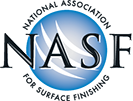| Presented in Partnership with: | |||
 |
 |
 |
 |
Bradley M. Miller, Area Supervisor
Permits and Enforcement
Hamilton County Department of Environmental Services
1632 Central Parkway, Room 201
Cincinnati, Ohio 45210-1604Re: Clarification of Chrome Plating NESHAP 40 C.F.R. § 63.343(c)(5)
Dear Mr. Miller:
I am writing in response to the April 30, 1998, letter to the United States Environmental Protection Agency (U.S. EPA) Region 5 from the Hamilton County Department of Environmental Services (DOES) in which you requested clarification of an issue under 40 C.F.R. Part 63, Subpart N (Chrome Plating NESHAP). Specifically, your letter requests clarification of 40 C.F.R. § 63.343(c)(5) regarding the surface tension limit that must be maintained by a hard chromium electroplating facility using a wetting agent for control of chromium air emissions.
As noted in your letter, 40 C.F.R. § 63.343(c)(5) states, in pertinent part, that "the owner or operator shall establish as the site-specific operating parameter the surface tension of the bath ... setting the maximum value that corresponds to compliance with the applicable emission limitation. In lieu of establishing the maximum surface tension during the performance test, the owner or operator may accept 45 dynes/cm as the maximum surface tension value that corresponds to compliance with the applicable limitation." Your letter stated that it is unclear whether or not a hard chromium electroplating facility may adopt the 45 dynes per centimeter limit if the facility has already conducted a performance test and demonstrated compliance while maintaining a surface tension other than 45 dynes per centimeter.
40 C.F.R. § 63.343(c)(5) goes on to state that "the owner or operator is exempt from conducting a performance test only if the criteria of paragraph (b)(2) of this section are met." 40 C.F.R. § 63.343 (b)(2) applies only to decorative chromium electroplating tanks and chromium anodizing tanks. In addition, the Chrome Plating NESHAP Background Information Document (BID) states that "hard chromium electroplating sources can use fume suppressants to achieve compliance with the standard, as long as compliance testing and ongoing compliance monitoring demonstrate that the emission limit required by the standard is being achieved." (Please see enclosed excerpt for further information.)
In response to your April 30, 1998, letter, after review of relevant information U.S. EPA Region 5 has determined that hard chromium electroplating facilities subject to the Chrome Plating NESHAP that use fume suppressants as all or part of their emission control system must conduct a performance test to demonstrate compliance with applicable emission limits and establish as the site-specific operating parameter the surface tension of the bath, for each surface tension value they wish to use. Therefore, a hard chromium electroplating facility may not accept 45 dynes per centimeter as a site-specific operating parameter without first conducting a performance test to prove that 45 dynes per centimeter corresponds to compliance with the applicable emission limitation.
If you have any further questions regarding this issue, please feel free to contact Julie Brandt, of my staff, at (312) 886-6768.
Sincerely yours,
George T. Czerniak, Chief
Air Enforcement and Compliance Assurance BranchEnclosure
cc: Scott Throwe, U.S. EPA OECA
Sherri Swihart, Ohio EPA
 |
 |
 |
 |
 |
| Home | Subscribe | Regulations | Compliance Assistance | News | Resources | Resource Locators | Directories | Online Training | About | Search | NASF.org |
The information contained in this site is provided for your review and convenience. It is not intended to provide legal advice with respect to any federal, state, or local regulation.
You should consult with legal counsel and appropriate authorities before interpreting any regulations or undertaking any specific course of action.
Please note that many of the regulatory discussions on STERC refer to federal regulations. In many cases, states or local governments have promulgated relevant rules and standards
that are different and/or more stringent than the federal regulations. Therefore, to assure full compliance, you should investigate and comply with all applicable federal, state and local regulations.